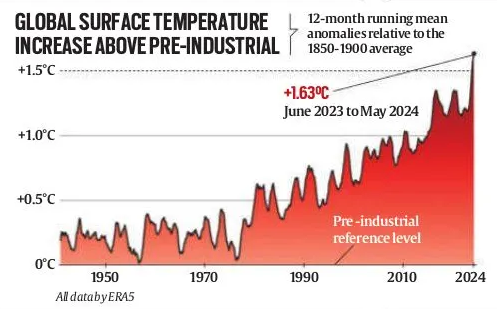Table of Contents
Context
- Over the past year, each month has consecutively set a new record for being the warmest of that specific month, according to Europe’s Copernicus Climate Change Service (C3S).
- The 12-month period from June 2023 to May 2024 averaged 1.63 degrees Celsius above the same baseline.

The 1.5°C Threshold/ Paris Agreement
- The 2015 Paris Agreement aims to keep global temperatures “well below” 2 degrees Celsius above pre-industrial levels by 2100, with a preference for staying within a 1.5-degree Celsius limit.
- The 1850-1900 period is generally used as the baseline for these measurements due to its reliable, near-global climate data.
- Significance of 1.5°C Threshold: Exceeding 1.5°C for extended periods could lead to irreversible and catastrophic climate change impacts.
- When will it be breached?: The World Meteorological Organization (WMO) projects an 80% chance that at least one year between 2024 and 2028 will exceed a 1.5-degree Celsius increase over pre-industrial levels, marking a historical first.
- What happens if it’s breached?: Increased sea-level rise, intense floods, droughts, wildfires, and other devastating consequences.
- Evidence of Climate Change Impacts:
- Extreme Heat Waves: The severe heatwave in North and Central India in May 2024, with temperatures near 50°C, was about 1.5°C warmer than previous heatwaves and caused hundreds of deaths.
- Coral Bleaching: The fourth global mass coral bleaching event was triggered by exceptionally high ocean temperatures, threatening marine life and livelihoods.
- Climate Tipping Points: Five major climate tipping points, critical thresholds that lead to irreversible changes, are at risk due to global warming. These include:
- Cryosphere: Melting of the Greenland ice sheet.
- Ocean-Atmosphere: Changes in water temperature.
- Biosphere: Death of coral reefs.
El Niño and Global Warming
- The year 2023 was the warmest calendar year on record, partly exacerbated by an El Niño event, known for causing widespread warming of ocean surface temperatures.
- The ongoing El Niño is expected to transition to La Niña, potentially moderating temperatures, but the 1.5-degree Celsius threshold is still likely to be breached temporarily in the next five years.
Required Global Actions
- GHG Emissions: Immediate and substantial reductions in greenhouse gas emissions, particularly from burning fossil fuels, are necessary to stay within the 1.5-degree limit.
- Example: Carbon dioxide levels in 2023 saw one of the highest annual increases in the past 65 years.
- Global Responsibility: As emphasised by UN Secretary-General António Guterres, urgent global action is required to divert from the current trajectory towards severe and irreversible climate impacts.


 Securities Markets Code Bill 2025: Towar...
Securities Markets Code Bill 2025: Towar...
 Weakly Interacting Massive Particles (WI...
Weakly Interacting Massive Particles (WI...
 India–Oman Trade Deal: CEPA Signed to ...
India–Oman Trade Deal: CEPA Signed to ...

























